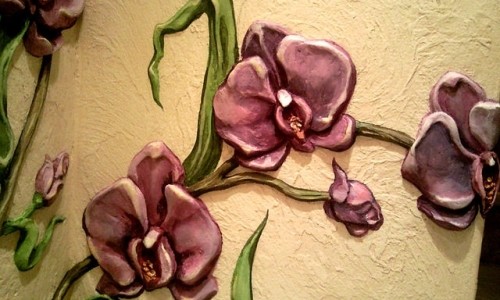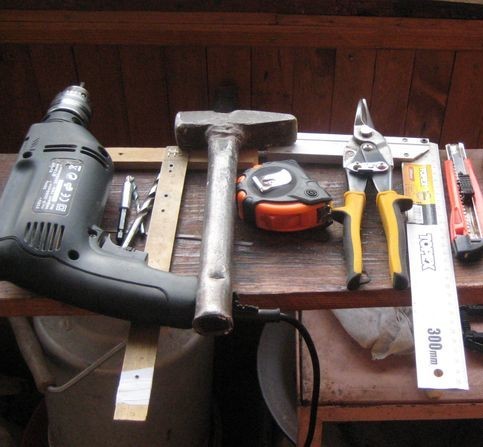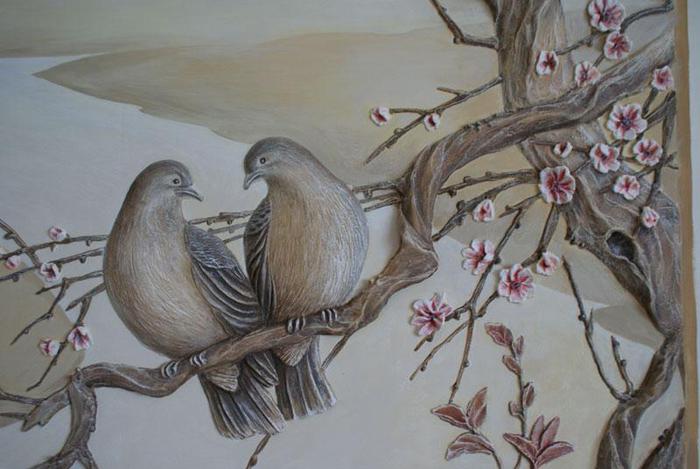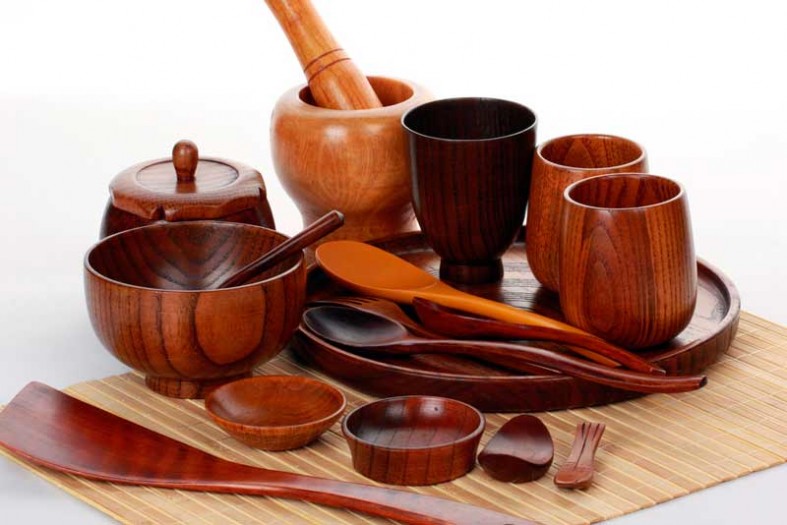The molding on the walls of the interior is alwayswas considered a sign of good taste and prosperity. Today, despite the fact that there is a wide variety of different plaster and plastic ready-made elements that can decorate the walls of a room in the house, but molding on the wall with your own hands will bring a lot of pleasure and make you proud of your work. Of course, you did it yourself. Someone, perhaps, thinks that molding on the wall is difficult. Not at all. Every person who has never even sculpted before, can easily cope with such work. It would be just a desire to create.  Beautifully decorated molding will decorate any wall, make it expensive and stylish.
Beautifully decorated molding will decorate any wall, make it expensive and stylish.
How to make a modeling on the wall with your own hands
This will require:
- building mix for plaster;
- sculptural clay (or other material);
- stacks, knife, mixing tanks;
- rolling pin.
Before proceeding to modeling, it should bePrepare the wall of the room, it must be carefully leveled with plaster. Clay for molding must be mixed so that it does not stick to the hands. From it, and will form the elements of the conceived composition. Part of the clay is kneaded in a container to the state of liquid sour cream. It is called a slip and is needed in order to connect ready-made elements among themselves.  Tools for modeling. You can sculpt anything, but most often make various plant compositions. From a piece of kneaded clay it is necessary to break off as much as it takes to create one element, and the rest of the clay should be wrapped in a wet cloth and a plastic bag. This will protect it from drying out. You can, for a simple example, consider how a grape bunch is very simply molded. You need to take a sheet of grapes, put it on a plastic wrap and circle it around the contour. This will be a template. Then clay and slip are mixed. A piece of clay is rolled with a rolling pin into a flat cake and is attached to the surface of the wall using a slip. The template is placed on the clay and outlined along the contour. Using tools to remove excess clay. You can use both professional tools (stacks) and any helpers. First, the contour of the sheet is formed, and then the inner part (veins and grooves) is formed. The sheet must be on the vine. Therefore, from the clay slides down a thin bundle and is attached to the wall. Then balls are rolled from the clay and a bunch of grapes is formed. After the preparation, the composition must dry. Then, together with the wall, it is covered with a primer and painted with water-based paint or whitened. You can make a color composition, adding colors to the paint and using art brushes. Back to contents</a> Molding using putty and otherMaterials Instead of sculpted clay, you can use putty. It is kneaded in a container, applied to a wall and, while the putty is moist, the elements of the composition are formed. It is recommended to form successively small areas, as this material dries out quickly enough. Instead of putty, you can use gypsum or alabaster.
Tools for modeling. You can sculpt anything, but most often make various plant compositions. From a piece of kneaded clay it is necessary to break off as much as it takes to create one element, and the rest of the clay should be wrapped in a wet cloth and a plastic bag. This will protect it from drying out. You can, for a simple example, consider how a grape bunch is very simply molded. You need to take a sheet of grapes, put it on a plastic wrap and circle it around the contour. This will be a template. Then clay and slip are mixed. A piece of clay is rolled with a rolling pin into a flat cake and is attached to the surface of the wall using a slip. The template is placed on the clay and outlined along the contour. Using tools to remove excess clay. You can use both professional tools (stacks) and any helpers. First, the contour of the sheet is formed, and then the inner part (veins and grooves) is formed. The sheet must be on the vine. Therefore, from the clay slides down a thin bundle and is attached to the wall. Then balls are rolled from the clay and a bunch of grapes is formed. After the preparation, the composition must dry. Then, together with the wall, it is covered with a primer and painted with water-based paint or whitened. You can make a color composition, adding colors to the paint and using art brushes. Back to contents</a> Molding using putty and otherMaterials Instead of sculpted clay, you can use putty. It is kneaded in a container, applied to a wall and, while the putty is moist, the elements of the composition are formed. It is recommended to form successively small areas, as this material dries out quickly enough. Instead of putty, you can use gypsum or alabaster.  Picture 1. Filled embossed painted walls decorate the nursery. The described method can decorate the wall with a relief. But you can make a three-dimensional image and decorate, for example, the wall or corner of the children's room. The child from such an ornament will be just delighted (photo 1). The easiest way to do all the same vegetable compositions, as in the example with grapes. Consider how you can fashion a three-dimensional branch of a tree with leaves and a bird sitting on it. In order for the branch to be voluminous, it is necessary to make a skeleton. It is made of wire, which is screwed to the wall of the room with the help of self-tapping screws. In the wall, in places of fastening, it is necessary first to drill holes and drive plastic dowels into them. The wire fixed to the wall should be wound with a bandage and coated with a solution of sculpted clay, putty, gypsum or alabaster. Using a knife, you need to form a tree bark on the resulting branch. It remains only to attach the leaves and plant a bird on the branch. The bird is easiest to fashion from clay, as it is more plastic. After drying, the entire composition is colored. You can use gouache or water-based paint, adding color to it. Looks like this decoration is great, especially if you make a highlight using a small spotlight with a directional beam of light. Back to contents</a> Decorating the living room with a stucco compositionThe living room can also be decorated with a large vegetable composition, fashioned from putty. It is necessary to choose an open surface that is not covered by interior elements and furniture. As already mentioned, the wall should be perfectly smooth. With plant elements, it is easier to work, since symmetry is not required. For the living room is more suitable composition with large details, for example, a large flower or tree.
Picture 1. Filled embossed painted walls decorate the nursery. The described method can decorate the wall with a relief. But you can make a three-dimensional image and decorate, for example, the wall or corner of the children's room. The child from such an ornament will be just delighted (photo 1). The easiest way to do all the same vegetable compositions, as in the example with grapes. Consider how you can fashion a three-dimensional branch of a tree with leaves and a bird sitting on it. In order for the branch to be voluminous, it is necessary to make a skeleton. It is made of wire, which is screwed to the wall of the room with the help of self-tapping screws. In the wall, in places of fastening, it is necessary first to drill holes and drive plastic dowels into them. The wire fixed to the wall should be wound with a bandage and coated with a solution of sculpted clay, putty, gypsum or alabaster. Using a knife, you need to form a tree bark on the resulting branch. It remains only to attach the leaves and plant a bird on the branch. The bird is easiest to fashion from clay, as it is more plastic. After drying, the entire composition is colored. You can use gouache or water-based paint, adding color to it. Looks like this decoration is great, especially if you make a highlight using a small spotlight with a directional beam of light. Back to contents</a> Decorating the living room with a stucco compositionThe living room can also be decorated with a large vegetable composition, fashioned from putty. It is necessary to choose an open surface that is not covered by interior elements and furniture. As already mentioned, the wall should be perfectly smooth. With plant elements, it is easier to work, since symmetry is not required. For the living room is more suitable composition with large details, for example, a large flower or tree.  Picture 2. Decorate the living room with stucco molding can be done with putty. First, a contour is drawn on the surface of the wall. Then it is possible to dissolve the putty and apply it with a spatula on the wall, immediately forming the necessary part of the part with the help of a knife and other improvised tools. If the putty dries, you can finish the job, gently cutting off the excess. But it is still easier to work with raw material. Work with putty is possible in another way, overlaying it with layers, forming a volume. Each layer must dry. The lower layers do not need to be smoothed, so they will be better kept by those that are superimposed on top. Some craftsmen recommend kneading putty, adding toilet paper to it to give the solution the best plasticity. Such a flower or tree on the wall of the room will not only decorate the room, but will also serve as a subject of your pride, because all this you have done yourself. So, decorating the walls with modeling is not difficult and does not require professional skills, especially if you use these helpful recommendations. You need to use your imagination to create a truly original composition (photo 2). It should be noted that the stucco composition looks many times more attractive if it is highlighted. Therefore, choosing a wall for work, you just need to determine where you can install the fixtures. </ ul>
Picture 2. Decorate the living room with stucco molding can be done with putty. First, a contour is drawn on the surface of the wall. Then it is possible to dissolve the putty and apply it with a spatula on the wall, immediately forming the necessary part of the part with the help of a knife and other improvised tools. If the putty dries, you can finish the job, gently cutting off the excess. But it is still easier to work with raw material. Work with putty is possible in another way, overlaying it with layers, forming a volume. Each layer must dry. The lower layers do not need to be smoothed, so they will be better kept by those that are superimposed on top. Some craftsmen recommend kneading putty, adding toilet paper to it to give the solution the best plasticity. Such a flower or tree on the wall of the room will not only decorate the room, but will also serve as a subject of your pride, because all this you have done yourself. So, decorating the walls with modeling is not difficult and does not require professional skills, especially if you use these helpful recommendations. You need to use your imagination to create a truly original composition (photo 2). It should be noted that the stucco composition looks many times more attractive if it is highlighted. Therefore, choosing a wall for work, you just need to determine where you can install the fixtures. </ ul>


